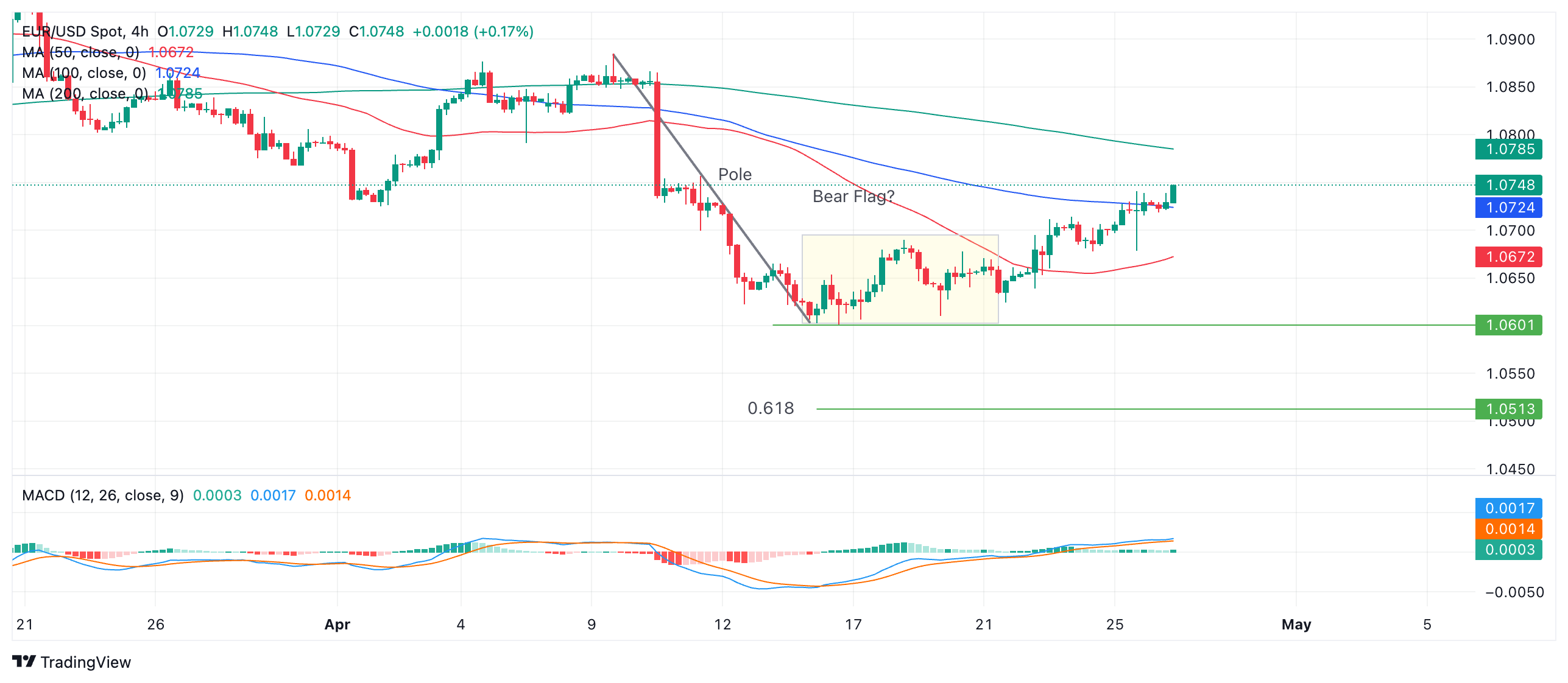- EUR/USD declines after a delay following the release of US PCE data.
- Core Personal Expenditures Price Index for March beats estimates.
- EUR/USD first edges higher but then weakens after the report.
EUR/USD trades back below 1.0700 on Friday as traders digest the implications of the March core Personal Consumption Expenditures Price Index (PCE), the US Federal Reserve’s (Fed) preferred gauge of inflation.
The pair popped higher immediately after the report was released but then broke substantially lower, falling back below the key 1.0700 handle, after core PCE data showed a higher-than-expected reading of 2.8% YoY, when analysts had expected 2.6% from 2.8% previously, according to the US Bureau of Economic Analysis (BEA). On month, Core PCE rose 0.3% in line with expectations and the same as previously.
Following the release, the probability of the Federal Reserve making an interest-rate cut in September from 59% on Friday morning prior to the event to 60% after.
Other data in the PCE report showed headline Personal Consumption Expenditures Price Index rising to 2.7%, beating estimates of 2.6% and a prior reading of 2.5%. On month, the PCE rose 0.3% as expected and the same as previous.
Personal Income rose 0.5% as forecast and Personal Spending 0.8%, beating estimates of 0.6% and the same as previous.
EUR/USD recovers from post-GDP data decline
EUR/USD declined sharply to a low of 1.0678 on Thursday following the release of US first-quarter GDP data. Although annualized GDP growth missed consensus expectations and fell below the previous quarter’s growth rate, the Personal Consumption Expenditures Prices component, which measures the change in prices of goods, came in way higher compared with previous quarter and supported the US Dollar (USD).
The inflationary data meant that markets dialed back their expectation of when the Federal Reserve (Fed) will start cutting interest rates, with the chance of a rate cut by the July meeting falling from 50% on the previous day to 34% afterwards, according to analysts at Deutsche Bank.
The expectation of interest rates staying higher for longer temporarily strengthened the Greenback – but weighed on EUR/USD – because higher interest rates attract more foreign capital inflows.
Technical Analysis: EUR/USD continues slowly correcting higher
EUR/USD continues correcting higher despite experiencing a pullback down below the 1.0700 level after the release of US GDP data on Thursday.
It has broken out of the rectangular range it was trading in on the 4-hour chart after piercing above the rectangle’s ceiling at 1.0700.
The Bear Flag price pattern which was unfolding between April 16-22 looks deformed by the persistent price action above 1.0700 and is less credible.
EUR/USD 4-hour Chart
The establishment of a rising sequence of peaks and troughs on the 4-hour chart strengthens the argument that the short-term trend has turned bullish and therefore suggestive of more gains.
If it continues marching higher, resistance from a previous lower high on April 11 gives an initial target at 1.0757. Then the 50-day and 200-day Simple Moving Averages (SMA) on the daily chart (not shown) are likely to resist at 1.0807.
On the other hand, a break below the 1.0601 April 16 low would revive the Bear Flag hypothesis.
According to technical lore, the expected move down from a Bear Flag equals the length of the preceding “pole” or a Fibonacci ratio of the pole.
The Fibonacci 0.618 ratio of the pole extrapolated lower gives a conservative target at 1.0503. The next concrete target is at 1.0448 – the October 2023 low. A fall of equal length to the pole would take EUR/USD to 1.0403.
Fed FAQs
Monetary policy in the US is shaped by the Federal Reserve (Fed). The Fed has two mandates: to achieve price stability and foster full employment. Its primary tool to achieve these goals is by adjusting interest rates. When prices are rising too quickly and inflation is above the Fed’s 2% target, it raises interest rates, increasing borrowing costs throughout the economy. This results in a stronger US Dollar (USD) as it makes the US a more attractive place for international investors to park their money. When inflation falls below 2% or the Unemployment Rate is too high, the Fed may lower interest rates to encourage borrowing, which weighs on the Greenback.
The Federal Reserve (Fed) holds eight policy meetings a year, where the Federal Open Market Committee (FOMC) assesses economic conditions and makes monetary policy decisions. The FOMC is attended by twelve Fed officials – the seven members of the Board of Governors, the president of the Federal Reserve Bank of New York, and four of the remaining eleven regional Reserve Bank presidents, who serve one-year terms on a rotating basis.
In extreme situations, the Federal Reserve may resort to a policy named Quantitative Easing (QE). QE is the process by which the Fed substantially increases the flow of credit in a stuck financial system. It is a non-standard policy measure used during crises or when inflation is extremely low. It was the Fed’s weapon of choice during the Great Financial Crisis in 2008. It involves the Fed printing more Dollars and using them to buy high grade bonds from financial institutions. QE usually weakens the US Dollar.
Quantitative tightening (QT) is the reverse process of QE, whereby the Federal Reserve stops buying bonds from financial institutions and does not reinvest the principal from the bonds it holds maturing, to purchase new bonds. It is usually positive for the value of the US Dollar.
Information on these pages contains forward-looking statements that involve risks and uncertainties. Markets and instruments profiled on this page are for informational purposes only and should not in any way come across as a recommendation to buy or sell in these assets. You should do your own thorough research before making any investment decisions. FXStreet does not in any way guarantee that this information is free from mistakes, errors, or material misstatements. It also does not guarantee that this information is of a timely nature. Investing in Open Markets involves a great deal of risk, including the loss of all or a portion of your investment, as well as emotional distress. All risks, losses and costs associated with investing, including total loss of principal, are your responsibility. The views and opinions expressed in this article are those of the authors and do not necessarily reflect the official policy or position of FXStreet nor its advertisers. The author will not be held responsible for information that is found at the end of links posted on this page.
If not otherwise explicitly mentioned in the body of the article, at the time of writing, the author has no position in any stock mentioned in this article and no business relationship with any company mentioned. The author has not received compensation for writing this article, other than from FXStreet.
FXStreet and the author do not provide personalized recommendations. The author makes no representations as to the accuracy, completeness, or suitability of this information. FXStreet and the author will not be liable for any errors, omissions or any losses, injuries or damages arising from this information and its display or use. Errors and omissions excepted.
The author and FXStreet are not registered investment advisors and nothing in this article is intended to be investment advice.
Recommended content
Editors’ Picks

Gold loses further impulse and breaches $3,400
Gold pulled back from its all-time high of $3,500 per troy ounce reached earlier on Tuesday, as a resurgent US Dollar and signs of easing tensions in the US–China trade dispute appeared to draw sellers back into the market.

EUR/USD retreats to daily lows near 1.1440
EUR/USD loses the grip and retreats to the 1.1440 zone as the Greenback’s rebound now gathers extra steam, particulalry after some positive headlines pointing to mitigating trade concerns on the US-China front on Tuesday.

GBP/USD deflates to weekly lows near 1.3350
GBP/USD loses further momentum and recedes to the 1.3350 zone on Tuesday, or two-day troughs, all in response to the frmer tone in the US Dollar and encouraging news from the US-China trade scenario.

3% of Bitcoin supply in control of firms with BTC on balance sheets: The good, bad and ugly
Bitcoin disappointed traders with lackluster performance in 2025, hitting the $100,000 milestone and consolidating under the milestone thereafter. Bitcoin rallied past $88,000 early on Monday, the dominant token eyes the $90,000 level.

Five fundamentals for the week: Traders confront the trade war, important surveys, key Fed speech Premium
Will the US strike a trade deal with Japan? That would be positive progress. However, recent developments are not that positive, and there's only one certainty: headlines will dominate markets. Fresh US economic data is also of interest.

The Best brokers to trade EUR/USD
SPONSORED Discover the top brokers for trading EUR/USD in 2025. Our list features brokers with competitive spreads, fast execution, and powerful platforms. Whether you're a beginner or an expert, find the right partner to navigate the dynamic Forex market.




